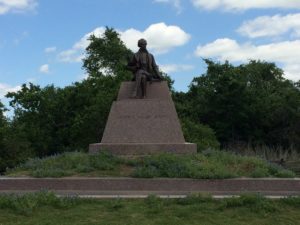
A statue of Stephen F. Austin marks the site of his settlement, San Felipe de Austin (Kathy M. Slaughter photo).
When one thinks of iconic Texas places, chances are the Alamo, Goliad, and the San Jacinto Battleground come to mind. More contemporary-minded people might think of the state Capitol building in Austin.
Yet none of these sites would have meaning, or possibly even come into existence, today had it not been for what took place at a little-known site located north of Interstate 10, just west of the Brazos River and east of Sealy.
In 1821, Stephen F. Austin continued the efforts of his late father, Moses, to bring Anglo-American families to settle in Texas, then a part of Mexico. The Mexican government granted permission for the colonization of land near the Brazos and Colorado rivers. Austin supervised the efforts from a newly created town, San Felipe de Austin. By 1835, San Felipe had a population of 600, which was second in size to San Antonio.
The Texas Revolution of 1836 changed things. Following the Battle of the Alamo, the Mexican Army was driving eastward across Texas, seeking to find and destroy General Sam Houston‘s army.
San Felipe residents didn’t want their town falling into the hands of the Mexican soldiers, so they burned it in what became known as the Runaway Scrape.
Following the revolution, with Texas an independent republic, San Felipe was rebuilt and made the county seat of Austin County. Eventually the county seat was moved to Bellville, where it remains today.
As for San Felipe, it never recaptured its original relevance. But eventually it became the site of the Stephen F. Austin State Park, a popular place for camping, golf, picnics and reunions. The actual site of the town was made into a state historical site, which features a replica of Austin’s cabin, the water well for the town, and a general store.
Local residents are working to raise the site’s profile. Archaeological digs have been made at and near the site. On FM 1458, across from the historic site, a new museum and visitor’s center are being built to encourage visitors to step back in time. Groundbreaking was in 2016. The museum is expected to open early next year.
According to an article in the Sealy News, the museum’s core exhibit will explore Austin’s life and role in Texas, along with the history leading up to the revolution.
The historical site is worth a visit.
